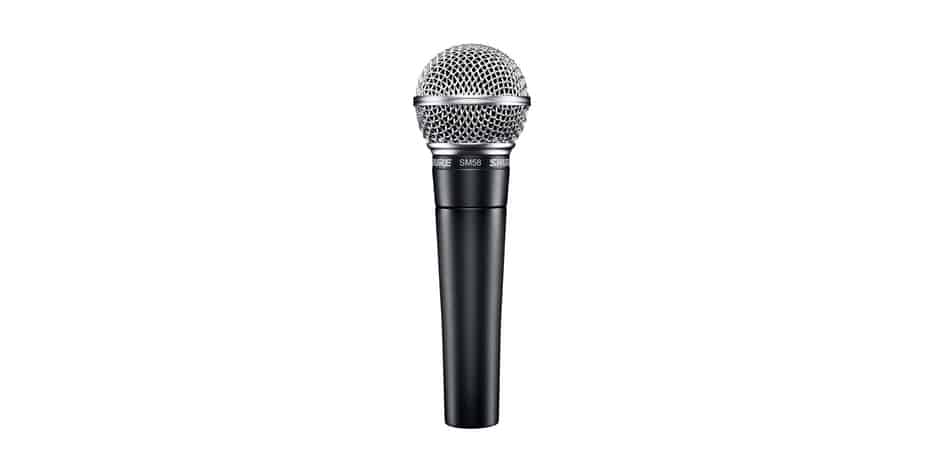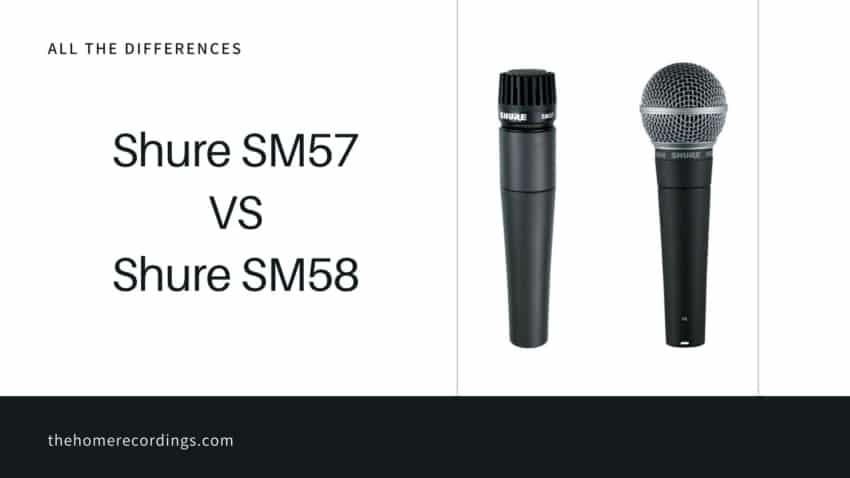Last updated on December 30th, 2023 at 02:49 pm
Both the Shure SM57 and the SM58 are two of the most used and best-know microphones out there.
From studios to live performances all over the world, they tend to be the go-to mics.
However, we all know that they are extremely similar microphones, in fact, they are almost identical.
This makes your decision a bit harder when thinking about which one you should get.
I this article I’ll do a quick overview of both microphones and I’ll also give you a detailed description about their differences overall, as well as my opinion on which one I think you should get first.
Let’s get started with the…
Shure SM57

Used to record guitar and bass cabinets, drums -especially snares-, and loads of other instruments all over the world, the SM57 is considered to be the best dynamic microphone for recording instruments.
The reason the SM57 is used for recording instruments and the SM58 is used for recording mostly vocals is because of the differences in their grilles.
The SM57 has a built-in grille that’s actually part of the cartridge, which means that the diaphragm of the microphone can be placed a bit closer to the sound source, whereas the SM58 has a ball grille that also works as a regular pop filter.
This ball grille on the SM58 means that there will be a bit more distance between the source and the diaphragm.
The closer the sound source, the more pronounced the proximity effect will be. So, you could say that the SM57 has a more pronounced proximity effect then.
This difference in grille design is also responsible for the SM57 having a slightly higher output above the 5kHz frequencies.
Now, let’s talk about the build quality:
The SM57 is built like an absolute truck; it can literally withstand anything you throw at it like being dropped on the ground, bumps, spills, and much more.
The reason for this is that it needs to be able to survive live shows and the life on the road.
Like I mentioned earlier, the SM57 has an increased presence peak, as does the SM58 but not as much, which brings out clarity both in the vocals and in the instruments that are recorded.
Features
- Most Popular mic in the world
- Great at recording almost any instrument
- Excellent for close-miking
- Perfect for studio and live shows
Specifications
| Polar Pattern | Cardioid |
| Microphone type | Dynamic |
| Frequency Response | 40 to 15,000 Hz |
| Output Impedance | Rated impedance is 150 Ohms (300 Ohms actual) |
| Connector | Three-pin (XLR), male |
| Sensitivity | -56dB |
Find out more about the Shure SM57 here:
- Shure SM57: Amazon, Sweetwater.
Shure SM58

The Shure SM58 is the Nr.1 vocal microphone in history; for live shows, studio sessions, live speeches, you name it.
There are actually four different versions of the SM58;
- SM58-CN (Cable included).
- SM58-LC (Cable not included).
- SM58S (On/Off Switch included).
- SM58-X2U (With XLR to USB adapter).
Which one you prefer totally depends on you, but the quality of the mic will be exactly the same no matter which version you choose.
The reason that the SM58 is considered to be one of the- of the best vocal mic in history, is because of how reliable it is and its excellent sound quality.
Not only that, but it’s extremely affordable.
Since it’s essentially the same microphone as the SM57, the build quality is just as good; It can deal with anything you throw at it and it will still sound amazing.
The ball grille is really good at reducing the plosives as well, which is why it’s a better vocal microphone than the SM57.
As far as the frequency response goes, it’s almost identical to the SM57;
It has a slight boost in the presence frequencies which simply helps bring out some clarity in the vocals.
However, the grille difference does affect this a bit and gives the SM57 a slightly higher boost than the SM58.
This difference is barely noticeable though, so don’t think that they both will sound completely different because of this.
Features
- Most famous vocal microphone in the world
- Perfect for studios and live shows
- The grille acts as a pop filter
- Built like a tank
Specifications
| Polar Pattern | Cardioid |
| Microphone type | Dynamic |
| Frequency Response | 50 to 15,000 Hz |
| Output Impedance | Rated impedance is 150 Ohms (300 Ohms actual) |
| Connector | Three-pin (XLR), male |
| Sensitivity | -57.5dB |
Find out more about the Shure SM58 here:
- Shure SM58: Amazon, Sweetwater.
What are the differences?
The SM57 and the SM58 are based on the same cartridge design, however the main difference is the grille. The SM58 uses a ball grille which is designed for vocal use since it acts as a pop filter. The SM57 was designed for recording instruments and that’s why it has a smaller grille, because pops and winds are not a concern.
Source: Shure Website.
Which one should you choose?
I all honesty, you can’t go wrong with either of them, especially since they are so affordable.
However, if this was my first microphone and I absolutely had to choose one, I’d go with the SM57.
The reason for this is because, like I already mentioned, the grille allows the source to be closer to the diaphragm, which is better for miking cabinets, drums, etc.
If you need to record vocals you can definitely do so; simply place a pop filter in front of the mic and that’s it! You’re good to go.
Basically, it’s a bit more versatile than the SM58.
However, if you need a purely vocal mic, then absolutely go with the SM58.
Find out more about the Shure SM58 and SM57 here:
- Shure SM58: Amazon, Sweetwater.
- Shure SM57: Amazon, Sweetwater.
What you will need in order to use these microphones
Almost every microphone, except USB ones, need an Audio Interface or a Mixer to work properly since they come with preamps that can increase the signal coming from the mic.
Even the most affordable interfaces out there are capable of this, so here’s a list of articles about Audio Interfaces and Mixers which you should check out if you still need to purchase one.
- Scarlett 2i2 VS UMC204HD
- Behringer UM2 VS UMC22
- Scarlett 2i2 VS Audient iD4
- Mixers with USB Multi-Track capabilities
- Wireless Multi-Track Mixers
Conclusion
Both of these microphones are one of the best investments you’ll ever make.
They cost very little, they last forever, and they also sound fantastic…
There’s a reason why you see dozens of these in every single music studio.
I hope this information was useful.
Have a wonderful day!
Frequently Asked Questions
Can the Shure SM57 be used as a vocal microphone?
Absolutely, but mostly in a studio setting.
The only thing you need to be careful of are the plosives, since it doesn’t come with a grille that acts like a pop filter like the SM58 does.
You will need to use an external pop filter for this, but other than that you’ll be completely fine.
Does a Shure SM57/SM58 need Phantom power?
No.
Dynamic microphones do not require phantom power to work.
Does the Shure SM57/SM58 need a Preamp?
Yes.
You need a preamp in order to amplify the signal, otherwise the level will be way too low to be really usable.
Does the Shure SM58 need a pop filter?
Technically no, since the grille already acts as one.
However, some plosives might still get through, which means that in a studio setting you could also place a regular pop filter in front of it.

hello there” im planning on buying the sm57 and i was wondering if the Audient iD4 MKII interface is a good match,thankyou for your time <3